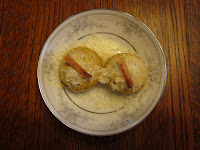I read Teaming with Microbes by Jeff Lowenfels and Wayne Lewis and published by Timber Press. The first part of the book is a fascinating overview of the biology of the various goodies living in a typical teaspoon of soil. It then goes on to investigate various ways in which this understanding applies to gardening.
I hadn't heard of the distinction between bacterially dominated soils (typical of annual gardens and grasslands) and fungal dominated soils (typical of perennial plantings and forests). I am also very interested to try the techniques for measuring soil life as a way to baseline and measure progress of the development of the soil food web. The section on composting enhanced my appreciation of the biological aspects of compost as a product for inoculating soil. I am also interested in trying AACT (actively aerated compost tea).
I highly recommend the book to anyone interested in the magic stuff that is soil.
Things that go bump in the night
10 years ago


















































